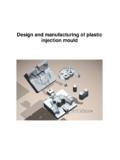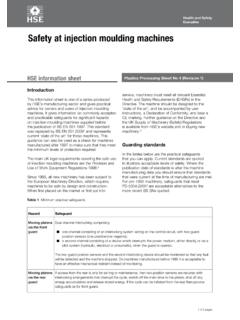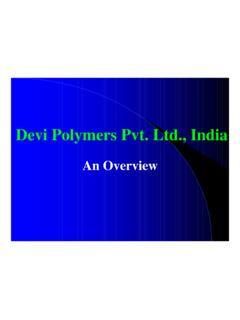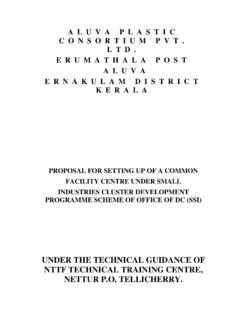Transcription of Design Guide English - Manterra
1 Design guidecontentsupdaterelease05//1997aENDes ignguideGE Plasticsrelease05//1997 Contents1 General Introduction1 Design Development .. Material Design factors .. Development steps .. requirements .. Design .. selection .. modification .. analysis .. analysis .. and testing .. testing ..112 Design for stiffness .. Introduction .. How to determine stiffness .. & loading .. factors influencing stiffness .. the stiffness .. analysis .. factors .. Increasing part stiffness .. of stiffness .. for part weight .. Selection .. considerations .. for stiffness to cost ratio ..163 Design for strength .. Introduction .. Material Strength .. strength .. strength ..20 Design to failure .. limit .. toughness .. measures .. Effects of various factors on strenght .. factors .. Part Strength .. part strength.
2 Yield strength .. toughness .. Improving part strength .. choice .. optimization .. Design considerations ..234 Design for behaviour over time .. Introduction .. time dependent phenomena .. recovery .. failure modes .. modulus .. relaxation .. considerations .. Dynamic time dependent phenomena .. and endurance limits .. affecting fatigue .. resistance .. of wear .. affecting wear ..295 Design for impact performance .. Introduction .. Common impact testing methods .. methods .. weight methods .. considerations ..33 Design guide1 Contents6 Design for appearance .. remarks .. Surface defects .. marks .. lines .. traps .. marks ..377 Design for precision .. Introduction .. shrinkage .. effects .. Shrinkage phenomena .. Materials and shrinkage .. materials .. materials .. materials.
3 Design related factors .. wall thickness .. related factors .. location .. type .. size .. Processing related factors .. temperature .. temperature .. time .. pressure .. effects .. expansion .. absorption ..42 Design crystallization .. under load .. Simulation techniques .. Summary ..438 Design for mouldability .. Introduction .. Material issues .. flow length .. properties .. properties .. temperature .. Shrinkage .. remarks .. Cooling time .. considerations .. remarks .. wall thickness .. ribs .. angles .. & lettering .. leaders .. lines .. Processing considerations .. Ejection ..549 Design for recyclability ..5510 Design for automation ..5711 Appendix ..59 Design guide1 ContentsThe intention of this Guide is toprovide the Design and engineeringcommunities with an insight into theconsiderations necessary whendesigning applications in engineeringthermoplastics.
4 Many of theseconsiderations relate to mouldingcriteria, so those involved in themanufacturing and processing ofplastics components should alsofind it , Design manuals deal with aspecific resin family, presentingproperties, Design criteria, assembly andother related information. GE Plastics product line includes crystalline,amorphous, thermoplastic elastomersand glass mat reinforced of this diversity, this brochurewill concentrate on issues common to allinjection mouldable Design Guide differs from most byvirtue of its Designing for concept,helping the reader move quickly to theissue that needs , discussion of certainaspects can occur in more than onesection, which demonstrates howintegral the process of designing forplastics is. Following the explanatorychapters is a section showing typicalengineering material performancegraphs for a range of GE Plasticsthermoplastic publications coveringassembly techniques, polymerprocessing considerations and overviewsof specific resins in the GE Plasticsproduct lines are available on addition, monographs discussingdetailed Design studies are releasedperiodically, covering these issues ingreater depth than is possible in thisgeneralized IntroductionThroughout the process of productdesign, both functional and materialaspects must be considered.
5 Functionaldesign factors relate to production andassembly. Material Design factorsconcern the performance of a materialin service. This performance, whichincludes strengths, weaknesses andlimitations, is investigated to provide thestarting point of the Design Material Design factorsConsiderable information is needed bythe Design engineer to develop aproduct Design from the initial can be a smooth process if carefulattention is given to each step designer must know the end-useperformance requirements of theproposed application. To determinewhether a material can meet theserequirements, the designer must be ableto rely on information provided by theraw material supplier, indicating theenvironmental and physical capabilitiesof the Development Establish end-use requirementsThe development of any componentstarts with careful consideration ofanticipated end-use general, the lower strengthproperties of polymers compared withmetals and woods require that productsbe designed to utilize a largerpercentage of their available information needed to establishend-use requirements includes:(a) Anticipated structural requirementsLOADST hese dictate the stresses a materialwill be subjected to, and they definecomponent OF LOADINGA thermoplastic may demonstratedifferent behaviour with changes inloading rate.
6 Therefore, in additionto its magnitude, the rate at whichloading is applied should OF LOADINGI nitial negligible deflectionsresulting from a small load maybecome unacceptably large if theload is FORCESB ecause the application of highloads for short periods of time mayresult in premature failure, thenature of impact forces to which thecomponent will be subjected shouldbe induces stress and deflectionchanges. Though these may besmall, component failure may occurthrough constant MISUSET hough structural requirements mayhave been satisfied, and anappropriate Design proposed, failurecan still occur as a result of establish the anticipated risklevel, therefore, a risk assessment ofthe product in use should be relevance tree method is idealfor this purpose, providing data tofacilitate assessment of foreseeablemisuse.
7 The results should then beweighed against the financial aspectsof the product. This exercise is oftencalled Product Risk Analysis .Additional details are not given heresince each company applies its Electric Plastics is preparedto provide assistance in this matterand, if required, contact should bemade with the nearest GE Plastics sales office.(b) Anticipated environmentsTEMPERATURE EXTREMESAll materials possess a workingtemperature range. Outside thisrange the component cannotproperly perform its intendedfunction. In addition, the propertiesof the material may vary considerablywithin working all thermoplastics are subject toattack by certain chemical agents,the service environment of theproposed component must exposure for prolongedperiods may result in materialdegradation.(c) Assembly and secondary operationsUsually a plastic component is notused in isolation but is just one of anumber of components making upthe end-product.
8 The techniqueused for assembly, such asmechanical fastening, welding andadhesive bonding, needs to beconsidered at the initial Design stageto optimize the component for easeof assembly, (and ease of handling inthe case of automated assembly), orease of disassembly for maintenanceand recycling. 91 Design developmentSecondary operations, such aspainting, printing and hot stamping,also have to be given earlyconsideration in order to Design thebest surface profile. This meansavoiding for example sink marks andsharp changes in shape to achieve ahigh quality smooth surface.(d) Cost limits The following should be established: Component cost resulting inprofitable sales Annual volume Economic processing method(s)with estimated cycle time(s) Tooling cost(s) for selectedprocessing method(s) The expected service life ofthe component(e) Regulations/standards complianceCheck which standards orregulations apply or can be appliedin the market place to thecomponent, product or appliance,for example.
9 STANDARDSIEC/CEEI nternational ElectricalCommittee/Commit Europ and Electricit ISO/CENI nternational StandardsOrganization/Commit Europ ande NormalisationDIND eutsche Industrie f rNormungen BSIB ritish Standards InstituteNFNormes FrancaisASTMA merican Society for Testingof MaterialsREGULATIONSULU nderwriters LaboratoriesCSAC anadian Standards AssociationCEEP ublications of the Commit Europ an d Electricit Factory and building Establish a preliminary designA preliminary concept sketch of theproposed component can help thedesigner to determine which aspects areinflexible, and which can be modified toachieve required preliminary sketch, therefore,should include both fixed and Select the materialA GE Plastics material should beselected that will satisfy initially defined,end-use requirements. The comparativeproperty data sheet should be the firstdocument which is consulted.
10 Initialselection may subsequently be refinedby reviewing the time, temperature andenvironment-dependent propertiesrelevant to the particular data, such as abrasionresistance or ductility, may be neededto confirm the selection. Material properties can be divided intotwo main categories.(a) Mechanical properties usedessentially for component designcalculations: Elastic limit Tensile strength Modulus vs temperature Poisson s ratio Apparent (creep) modulus Fatigue limit Coefficient(s) of thermal expansion Coefficient of friction Thermal conductivity Density Mould shrinkage(b) Other relevant properties: Hardness Impact strength Chemical resistance Weathering resistance Abrasion resistance Ductility Flammability Heat deflection temperature Electrical propertiesTo Design a plastic component,information concerning anycombination of material propertiesmay be required.






